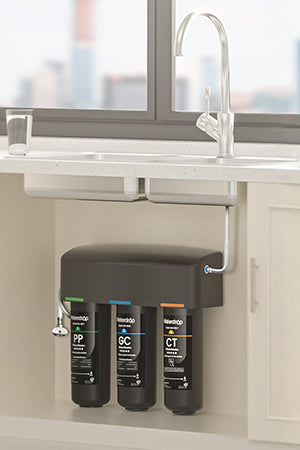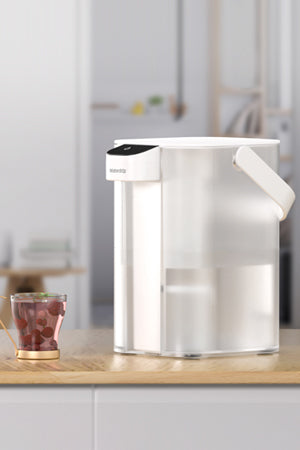Reverse osmosis (RO) systems are the best water purification technologies current. They eliminate contaminants like heavy metals, chemicals, and bacteria, and they give people in homes all over Singapore clean, great-tasting drinking water.
If you have ever glanced at the wastewater emerging through an RO system, you may be curious to know if you can reuse it or even drink it. After all, it is just like regular water. In this writing, we're going to break down what RO wastewater actually is, if it is drinkable, and how you're able to utilize it effectively inside your household.
What Is Reverse Osmosis Water?
In order to know if the RO waste water is potable, let us consider the operation of the reverse osmosis system.
Reverse osmosis employs the
semipermeable membrane to separate dissolved impurities present in water. When water gets forced through the membrane, clear water, known as permeate, gets filtered through, and dirty water, referred to as concentrate or reject water, gets removed.
This rejection water is nothing but the RO waste water. It's referred to as “waste” because it takes the contaminants the system filtered out. That way, the water you drink ends up as clean as possible.
Why Does Reverse Osmosis Provide Wastewater?
All filtration systems which remove impurities have any type of byproduct. For reverse osmosis, waste water is crucial for maintaining the RO membrane clean and avoiding clogging.
Here's why the RO waste water comes:
- It washed off the dissolved minerals and salts formed through filtration.
- It assists the extension of the life of the RO membrane.
- It maintains the system to continue to yield quality purified water.
Depending on the model, the waste-to-pure water ratio ranges typically 3:1 - 1:1 — i.e. to produce 1 liter of purified water, 1 - 3 liters of waste water are produced.
High-end RO systems such as
Waterdrop reverse osmosis water filters are developed to minimize water waste by half, providing 3:1 pure to drain ratio. They become even more sustainable and efficient, particularly for environmentally-friendly households in Singapore.
Can You Drink Reverse Osmosis Waste Water?
Short Answer: No, it's not advisable. RO waste water can be clean-looking, but you cannot drink it. This water has the concentrated foul matter eliminated from your filtered water — including minerals, salts, heavy metals, and even bacteria. Let us specifically examine why you should not drink it.
1. It Has High Impurity Content
The goal of the RO procedure is to remove pollutants from your tap water. Wastewater is the concentrated remainder — i.e., it has all the stuff you do not wish to have in your water. Consuming the water may bring toxic substances into your body and lead to health problems later. These impurities could be:
- Chlorine
- Fluoride
- Lead
- Arsenic
- Nitrate
- Microorganisms
- Excess Salts and Minerals
2. It Might Have Bacteria or Borne Diseases
Whereas the RO system prevents the passage of most microbes, the waste water lines and storing spaces become breeding centers of bacteria unless frequently cleansed. This therefore means the waste water harbors microbes and organics, and hence, not safe for direct drinking.
3. It Has an Unpleasant Taste
Even were it technically harmless, RO waste water usually has the salty or metallic flavor of the very high level of dissolved solids. It's far from drinkable and not drinkable or usable for cooking.
What Are the Uses of RO Waste Water?
While you shouldn't drink it, the RO waste water doesn't have to go to waste entirely. Actually, you can utilize it for the non-drinking purpose of your home. The following are some intelligent ideas to utilize the RO reject water of Singapore:
1. Wipe and Sweep the Floor
RO waste water is ideal for mopping floors or cleaning balconies. It has no dirty sight or huge particles and therefore can be used for any general cleaning job. Do not use it on surfaces which are prone to corrosion, as the contents are too rich and may deposit residue.
Tips: Clean the floor or balcony with clean filtered in the end to ensure there is no stains left by the waste water.
2. Toilet Flusher
Reusing the RO waste water, the best way is putting it in the toilet. This simple reuse saves dozens of liters of drinking water every day, particularly in big households. You are able to store the reject water in a container and use by hand or attach it right to the toilet flush tank using plumbing adaptations.
3. Washing Outdoor Space
RO waste water could be utilized to clean driveways, and outdoor furniture. However, do not have it dry on polished surfaces or glass, as it may leave white spots of minerals.
4. Watering Some Plants
Few hardy, tolerant plants such as money plants, bougainvillea, or aloe vera are capable of tolerating lightly mineralized water. You can make use of
RO waste water for these plants, but just test it once so the Salinity does not become too much. Do not use it for sensitive plants such as orchids or ferns, because excessive TDS content may damage the roots.
How to Reduce RO Waste Water at Home
These are some of the few strategies to make your reverse osmosis system more water-efficient:
1. Select a High-Efficiency System
Latest RO systems are developed through water-conserving technology to significantly reduce waste water production.
For instance, Waterdrop RO systems have the 3:1 pure-to-drain rate, i.e., for every 3 liters of fresh water produced, only 1 litre gets rejected. Conventional systems may waste 3 liters. This makes all the difference to the household of Singapore looking to save water and pay reduced utility bills.
2. Use the Waste Water Meritoriously
As previously mentioned, divert RO waste water to non-potable uses like cleaning or flushing. This task could be made uncomplicated and self-automating by installing an ordinary diverter valve.
3. Keep Your RO System Regularly Maintained
An effectively maintained system works better and losses fewer waters. Replace filters on schedule and clean the RO membrane every few months to run best.
People Also Ask
Is reverse osmosis waste water reusable?
Yes, you may reuse it for the purpose of cleaning, flushing the toilet, or garden. Nevertheless, it cannot be directly consumed.
Why does my RO system waste so much water?
RO systems have waste water as part of the cleaning system. The waste water takes the impurities the membrane filtered, leaving your drinking water clean.
Can you re-filter your RO waste water for drinking?
Technically yes, but it's not advisable. You would require an additional filtration cycle, which takes a toll on water and energy. It's more practical to spend money on a higher-efficiency RO system so it doesn't waste so much stuff to begin with.
Is waste water of RO harmful for the environment?
It does not contain any toxins but has concentrated minerals and salts. If it comes out in huge amounts, it gives elevation to the soil or the drain's salinity. Reusing the water conscientiously for domestic works would be the best remedy.
Final Words
Therefore, you are able to drink waste water of reverse osmosis? The reply is no. RO waste water has all the impurities, salts, and sediments removed by your system from your kitchen-sink tap water. Although it appears clear, it's not drinkable.
That being said, you can still utilize your RO waste water for good — i.e., for cleaning, flushing, or plantation — and save water and waste. For consumers in Singapore seeking to drink clean, fresh, and delicious water while wasting the least,
Waterdrop reverse osmosis systems are a brilliant investment. Equipped with advanced water-saving technology, modern and compact designs, and exemplary filtration efficiency, they give you the best of purification by wasting the least — making clean drinking water both sustainable and convenient.





































































